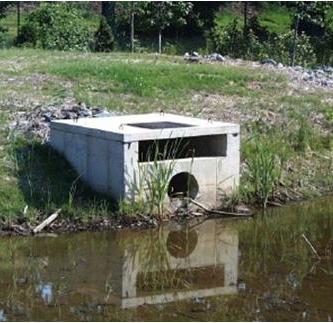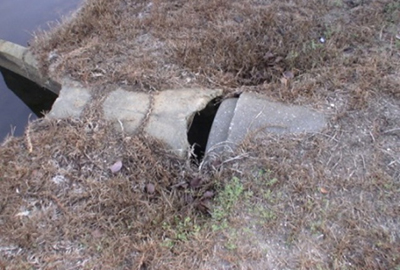Stormwater retention ponds are designed to minimize the adverse effects that impervious surfaces have on watersheds. Impervious surfaces (ie. paved surfaces, buildings, etc.) increase the volume of surface runoff in a watershed because they prevent rain water from infiltrating into the soil. Also, pollutants that collect on impervious surfaces are not filtered by the soil or plants and are conveyed directly to rivers and beaches without treatment. To reduce the potential flooding and water quality problems, stormwater regulations require new developments to capture and manage runoff. Stormwater ponds help developments meet stormwater regulations by reducing the potential for flash flooding and removing sediments and other pollutants carried in stormwater runoff.
-
How do stormwater ponds work?
Flood Control: Stormwater ponds detain stormwater in order to prevent flooding and minimize erosion. They do so by collecting runoff in a basin of a predetermined volume. The basin is designed to fill with water during the storm and discharge the water through an outlet structure which releases water at a rate similar to the rate of flow before the watershed was developed. To capture runoff, each stormwater pond must have an empty space that can fill with water during the storm. The empty space from the normal water level to the top of the bank slope is known as the temporary storage capacity.
Water Quality Protection: Stormwater ponds are designed to permanently retain water in the basin. This volume of water is known as the permanent pool or treatment pool. In South Carolina, the treatment pool must be the same volume as if 1 inch of rainfall were to fall on the watershed that drains to the pond. The treatment pool is designed to slow the water down and hold it long enough to allow gravity to pull sediments out of the water column and allow sunlight and biochemical processes to break down pollutants before they are released to rivers and beaches. In most cases the treatment pool has an average depth of 4 to 6 feet, which has been shown to limit submerged vegetation and provide the necessary treatment and sediment capture.
-
Parts that are common to all stormwater ponds:
The Basin: Every stormwater pond has an excavated basin with a specific volume. The part of the basin that permanently retains water is known as the treatment pool. The empty space above the treatment pool to the top of the bank slopes is known as the temporary storage which fills and drains with each storm event.
Treatment pool - designed to permanently hold at least the first 1 inch of rainfall that falls on the area of the development that drains to the pond. The treatment pool must be large enough to hold water long enough to allow gravity to remove sediment and debris and allow sunlight and biochemical processes to remove other pollutants such as bacteria and nutrients.Temporary Storage - usually designed to be large enough to accommodate the "25-year storm" (a storm that is likely to occur at least once every 25 years). In coastal South Carolina, this means a storm that drops just over 7 inches of rain in 24 hours.Inlets and Forebays: Stormwater is conveyed from roads, parking areas, roof tops, and lawns through pipes and swales into the pond. The inlets are where stormwater runoff is discharged into the pond. Forebays are areas around inlets where the heaviest sediments settle. Forebays may lie within the basin or may be depressed areas outside of the basin.
Littoral Shelf: The submerged area near the edge of the pond where the sunlight can penetrate through the water to the bottom is the littoral zone. In many ponds, this area is a shallow shelf that provides habitat for fish; emergent wetland plants provide water treatment and stabilize the base of the bank slope.
Outlet Control Structure: The most critical component of the pond is the outlet control structure that regulates the water level and maintains the permanent pool. This may be a weir, concrete riser, spillway or inverted pipe. According to design standards, the surface of the permanent pool should return to the level of the bottom of the outlet control structure within 24 hours after the storm.

-
Sedimentation
Since a primary function of a stormwater pond is to trap debris and sediment, all stormwater ponds will accumulate sediment and will need to be dredged. The frequency of dredging is highly variable and is dependent on:
- the amount of exposed soils eroding from construction sites in the development,
- the rate of shoreline erosion
- the amount of aquatic plant growth and decay,
- the amount of debris released into the drainage system by residents and workers.
Stormwater ponds should be dredged when the permanent pool volume is half-filled with sediment because the pond is no longer effectively removing sediment and pollutants once filled to that level. For instance, if a stormwater pond was constructed to have an average depth of 6 feet, it will need to be dredged when the average depth reaches 3 feet. The permanent pool volume must be maintained to ensure proper water quality treatment and control of submerged aquatic vegetation. If you suspect that your pond is in need of dredging, contact your county or municipal stormwater division for guidance. You will need to retain the services of an engineer who can assess the need and draw plans for remediation. The stormwater pond’s ability to manage nutrients is also limited by accumulation of sediments, so if your pond is consistently eutrophic, dredging should be considered. Also, maintaining depth is critical to preventing undesirable vegetation from taking over the pond.

-
Other Structural Problems
Areas where water energy is concentrated such as swales, inlet pipes, and outfalls sometimes break or separate and need repair. Gulleys may form on bank slopes where swales concentrate surface runoff. Inlet pipes sometimes crack, collapse or shift. Sinkholes may develop over areas where buried pipes separate, and cracks form in outfalls as they settle. Sometimes trees, vines, and other woody vegetation overtake inlets and outfalls and needs to be removed. If any of these problems occurs, you should consult with your county or municipal stormwater division. In some instances, they may be able to assist with the problem. If not, your community will need to retain the services of an engineer who can design the necessary repair.

-
The Importance of Maintaining a Capital Reserve Account
Dredging and structural repairs are expensive, so it is recommended that the home owners association or business(es) maintain reserve funds for such expenses to reduce the need for a special assessment on the property owners. Setting aside a small percentage of the dues will generate revenue that can be used for expensive capital projects. The amount of revenue allocated to the capital reserve should be relative to the size of the ponds and number of inlets. The cost of dredging and repairs is highly variable and depends on access, degree of work, disposal of spoils and broken material, permits, and other environmental concerns, so it is recommended that communities consult with a civil engineer before seeking bids. The engineer can help design the repair and walk through any permitting that may be necessary.
-
Inspect your system
It is important that all inlets and outlets be inspected regularly to prevent blockages and to check for structural failures. Sinkholes and erosion around inlets should be repaired as soon as they are found because they can grow exponentially once started. Large trees and shrubs should not be allowed to grow around inlets and outlets and should be minimized within the basin to allow for maintenance access. On occasion, the outlet pipe can collapse or become clogged below ground. This will cause the pond to drain slowly and have elevated water levels beyond 24 hours after the storm. If you suspect a blockage in your pipes, you should consult with your municipal stormwater division or have an engineer inspect the outlet.
-
Post Construction Inspections
Municipalities (MS4s) that are regulated under the Clean Water Act NPDES program may be required to conduct post construction inspections of private drainage systems in their permitted area to ensure proper functioning of the stormwater systems. These inspections will be conducted by municipal staff and will look mainly for structural problems with the system (broken inlets/outlets, blockages, vegetation, sediment accrual, sink holes, etc.). Each municipality has a different process for inspecting permitted private systems, but these are usually handled through the Department of Public Works or Stormwater Department. If you are a new HOA board member or community manager, we recommend communicating with your municipality regarding the status of your stormwater drainage system, especially if there are known problems.

